Introduction
In this article we are going to look
at Microsoft .NET Framework. This is the newly established
software development environment which helps developers
to develop applications quickly and gives optimum,
efficient, scalable, performance oriented applications
in different languages like Visual Basic .NET, C#,
ASP .NET, and Jscript .NET etc?
Overview of the .NET Framework
The .NET Framework is a new computing platform that
simplifies application development in the highly distributed
environment of the Internet.
Services
NET Framework provides the following services:
- Tools for developing software
applications,
- run-time environments for
software application to execute,
- server infrastructure,
- value added intelligent
software which helps developers to do less
coding and work efficiently,
The .Net Framework will enable
developers to develop applications for various
devices and platforms like windows application web
applications windows services and web services.
Objectives
The .NET Framework is designed to fulfill the
following objectives:
- A consistent object-oriented
programming environment, where object code can
be stored and executed locally, executed locally
but Internet-distributed, or executed remotely.
- A code-execution environment
that minimizes software deployment and
versioning conflicts.
- A code-execution environment
that guarantees safe execution of code,
including code created by an unknown or
semi-trusted third party.
- A code-execution environment
that eliminates the performance problems of
scripted or interpreted environments.
- Developers can experience
consistency across widely varying types of
applications, such as Windows-based applications
and Web-based applications.
- Build all communication on
industry standards to ensure that code based on
the .NET Framework can integrate with any
other code.
Understanding the .NET Framework Architecture
The .NET Framework has two components: the .NET
Framework class library and the common
language runtime.
The .NET Framework class library facilitates
types (CTS) that are common to all .NET languages.
The common language runtime consists of
(class loader) that load the IL code of a program
into the runtime, which compiles the IL code into
native code, and executes and manage the code to
enforce security and type safety, and provide thread
support.
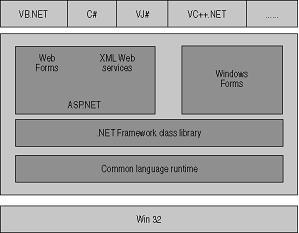
.NET Framework Architecture has
languages at the top such as VB .NET C#, VJ#, VC++
.NET; developers can develop (using any of above
languages) applications such as Windows Forms, Web
Form, Windows Services and XML Web Services. Bottom
two layers consist of .NET Framework class library
and Common Language Runtime. This we are going to
understand using this article.
Understanding the Roll of .NET Framework.
The .NET Framework has two main components: the
common language runtime (CLR) and the .NET Framework
class library. The common language runtime is the
foundation of the .NET Framework. CLR act as an
agent that manages code at execution time, providing
core services such as memory management, thread
management, and remoting, while also enforcing
strict type safety and facilitates with code
accuracy that ensure security and robustness. The
concept of code management is a fundamental
principle of the CLR. Code that targets the CLR is
known as managed code, while code that does not
target the CLR is known as unmanaged code.
The class library, is a integral component of the
.NET Framework, consists of object-oriented
collection of reusable classes (types) that we can
use to develop applications ranging from traditional
command-line or any graphical user interface (GUI)
applications such as Windows Forms, ASP. NET Web
Forms and Windows Services the newly invented XML
Web services.
The European Computer Manufacturers Association (ECMA)
standard has defines the Common Language
Specification (CLS); this enforces that software
development languages should be interoperable
between them. The code written in a CLS should be
compliant with the code written in another CLS-compliant
language. Because the code supported by CLS-compliant
language should be compiled into an intermediate
language (IL) code. The CLR engine executes the IL
code. This ensures interoperability between CLS-compliant
languages. Microsoft .NET Framework supports
Languages like Microsoft Visual Basic .NET,
Microsoft Visual C#, Microsoft Visual C++ .NET, and
Microsoft Visual J# .NET.
The language compilers generate an Intermediate
Language code, called Microsoft Intermediate
Language (MSIL), which makes programs written in the
.NET languages interoperable across languages.
The ECMA standard, Common Language Infrastructure
(CLI), defines the specifications for the
infrastructure that the IL code needs for execution.
The CLI provides a common type system (CTS) and
services such as type safety, managed code execution
and side by side execution.
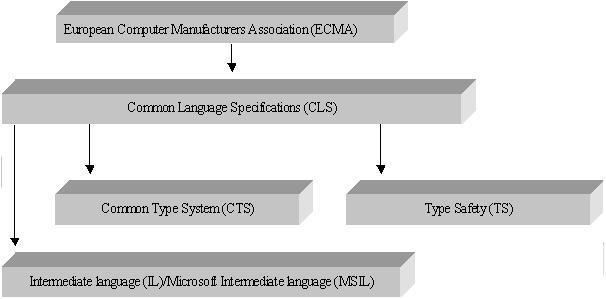
Figure 1.
ECMA Standards under Microsoft .NET Framework.
The .NET Framework provides the infrastructure and
services. The CLI specifications. These include:
- Common language runtime.
- The CLR includes the CLI,
- The CLR also provides the
execution environment for .NET Applications.
- Common type system.
- Provides the data types,
values, object types. This helps developers
to develop applications in different
languages.Where .NET languages share CTS
mean all the types used in applications
shares the same types defined under CLI.
- Type safety.
- .NET Framework performs
operations on the values or objects for
which .NET Framework requires each value or
object has a type and which reference to the
value or object type.
- Managed code execution.
- .NET Framework manages the
state of the object while executing the .NET
Applications.
- .NET Framework
automatically allocates memory and provides
garbage collation mechanism to de-allocate
memory.
- Side-by-side execution.
- .NET Framework allows
different version of the same application to
run on the same machine by using assemblies
of different versions. Assemblies consist of
IL Code and Metadata. Where metadata
determines the application dependencies. By
this .NET Framework Runtime executes
multiple version of assembly and solves the
major problem of legacy development
environment. That is the 揇LL HELL?
.NET Assembly
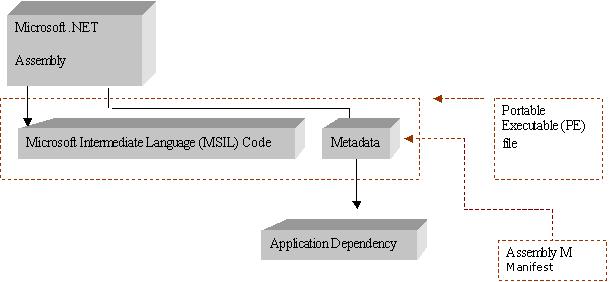
Figure 2 Side-by-side
Execution.
Understanding .NET Framework CLR
The common language runtime facilitates the
followings:
- Run-time environment
- CLR Compiles application
into the runtime, compile the IL code into
native code, execute the code
- Run-time services.
- Memory management,
- Type safety,
- Enforces Security,
- Exception Management.
- Thread support
- Debugging support
Understanding Architecture of .NET Framework CLR
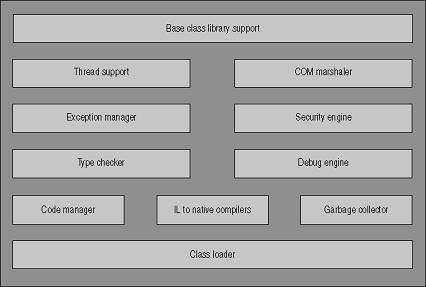
- Class loader, which loads
classes into CLR.
- MSIL to native code compiles,
this converts MSIL code into native code.
- Code manager, this manages the
code during execution.
- Memory allocation and Garbage
collector, this performs automatic memory
management.
- Security engine, this enforces
security restrictions as code level security
folder level and machine level security using
tools provided by Microsoft .NET and using .NET
Framework setting under control panel.
- Type checker, which enforces
strict type checking.
- Thread support, which provides
multithreading support to applications.
- Exception manager, which
provides a mechanism to handle the run-time
exceptions handling.
- Debug engine, which allows
developer to debug different types of
applications.
- COM marshaler, which allows
.NET applications to exchange data with COM
applications.
- Base class library support,
which provides the classes (types) that the
applications need at run time.
Features of the Common Language Runtime
The CLR has the following Fractures
- Manages memory,
- Allocation of Memory
- De-Allocation of Memory
(garbage collation)
- Thread execution support,
- Code execution,
- Code safety verification,
- Compilation.
- Code Security based on Trust
(granted permission to execute code. Code level,
Folder level, Machine level) These features are
intrinsic to the managed code that runs on the
common language runtime.
Understanding CLR
To execute the program and gain all the benefits of
managed execution environment we write code in a
language which is supported by CLS that is .NET
Framework. The language compiler compiles the source
code into the MSIL code which consists of CPU-
independent code and instructions which is platform
independent. MSIL consists of the followings:
- Instructions that enables to
perform arithmetic and logical operations
- Access memory directly.
- Control the flow of execution,
- Handles exceptions,
MSIL code can be compiling into CPU
specific instructions before executing, for which
the CLR requires information about the code which is
nothing but metadata. Metadata describes the code
and defines the types that the code contains as well
referenced to other types which the code uses at run
time.
An assembly consists of portable executable file. At
the time of executing PE file the class loader loads
the MSIL code and the metadata form the portable
executable file into the run time memory.
Before the execution of PE file it passes the code
to the native code compiler for compilation, IL to
native code compilation is done by JIT compiler. For
different CPU architecture and compilers for the IL
code in to the native instructions.
Futures of CLR
- Managed multithreading support
and monitor the threads. Application domain
contains one or more threads to execute.
- Manages interoperability with
unmanaged code, and COM marshaling
- A structured exception handling
mechanism,
- The infrastructure and managed
execution process, memory management and garbage
collection.
Architecture of CLR
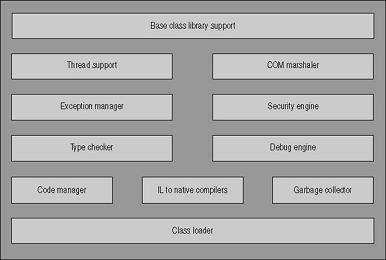
- Base class library support
supports al the base classes used for .net
languages to support basic functionality
- COM Marshaler supports
Marshaling of data between COM objects.
- Exception management supports
handling Errors at runtime using try catch
finally blocks.
- Security engine enforces
security rules at runtime.
- Type checker checks for Type
safe checks at runtime.
- Debug engine supports debugging
at runtime.
- Code manger manages the Managed
code at runtime.
- IL to native compiler compiles
the MSIL code to the Native code which is
machine independent
- Garbage collector supports the
Memory management and supports Clearing unused
memory at runtime.
- Class loader lodes the classes
at runtime
Understanding JIT compiler
JIT compiler compiles is the integral part of CLR.
the MSIL code to Native code and executes the batch
of code Just in time which will be cached and next
time when the code gets executed from cache in stud
of compiling again.
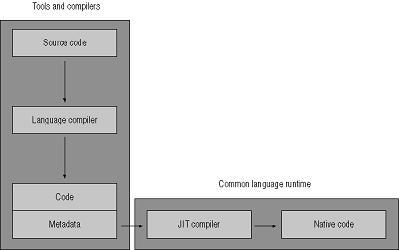
JIT Execution process.
CLR class loader lodes MSIL code and metadata are
loaded into memory; the code manager calls the entry
point method which is WinMain or DLLMain method. The
JIT compiler compiles the method to before its
execution of the entry point method. The code
manager places the objects in memory and controls
the execution of the code. The garbage collector
performs periodic checks on the managed heap to
identify the objects which is not in use for the
application.
At the time of program execution the type checker
ensures that all objects and values, and the
references of objects and values has its valid type.
The type checker also makes sure that only valid
operations are performed on the code other wise the
exception will be thrown. The code is controlled by
CLR at run time. CLR enforces security in following
manner.
- To control and access the
system recourses like hard disk
- To control and access the
network connections
- To control and access the other
hard ware resources.
Managed code Execution
Managed code execution is known as the process
executed by the CLR which is as follows:
- CLR loads the MSIL & refers
metadata,
- CLR executes the Native code,
- CLR provides automatic memory
management.
- Managed execution also performs
JIT compilations,
- Ensuring type safety,
- Enforcing security,
- Handling exceptions.
Managed Execution Process
- Managed code is
self-explanatory code which gives information to
CLR for multiple runtime services in .NET
Framework.
- This information is stored in
MSIL code in the form of metadata inside the PE
file. Mata data information will describe the
types that the code contains.
- Managed data is allocated and
released from memory automatically by garbage
collection. Managed data can be accessible form
managed code but managed code can be accessible
from managed and unmanaged data.
Memory Management
Automatic memory management means no need to
write code to allocate memory when objects are
created or to release memory when objects are not
required the application.
The process of automatic memory management involves
the following tasks:
?Allocating memory
- When a process is initialized,
the runtime reserves a contiguous address space
without allocating any storage space for it.
- This reserved address space is
called a managed heap. The managed heap keeps a
pointer at the location where the next object
will be located.
- When an application uses the
new operator to create an object, the new
operator checks whether the memory required by
the object is available on the heap.
- When the next object is
created, the garbage collector allocates memory
to the object on the managed heap.
- Allocating memory to the
objects in a managed heap takes less time than
allocating unmanaged memory.
- In unmanaged memory, the
pointers to memory are maintained in linked-list
data structures. Therefore, allocating memory
requires navigating through the linked list,
finding a large memory block to accommodate the
- You can access objects in
managed memory faster than objects in unmanaged
memory because in managed memory allocation,
objects are created contiguously in the managed
address space.
?Releasing Memory
- The garbage collector
periodically releases memory from the objects
that are no longer required by the application.
- Every application has a set of
roots. Roots point to the storage location on
the managed heap. Each root either refers to an
object on the managed heap or is set to null.
- An application's roots consist
of global and static object pointers, local
variables, and reference object parameters on a
thread stack.
- The JIT compiler and the
run-time maintain the list of the application
roots. The garbage collector uses this list to
create a graph of objects on the managed heap
that are reachable from the root list.
- When the garbage collector
starts running, it considers all the objects on
the managed heap as garbage.
- The garbage collector navigates
through the application root list, it identifies
the objects that have corresponding references
in the application root list and marks them as
reachable.
- The garbage collector also
considers such objects as reachable objects.
- The garbage collector considers
all unreachable objects on the managed heap as
garbage.
- The garbage collector performs
a collection process to free the memory occupied
by the garbage objects.
- The garbage collector performs
the memory copy function to compress the objects
in the managed heap.
- The garbage collector updates
the pointers in the application root list so
that the application roots correctly point to
the objects to which they were pointing earlier.
- The garbage collector uses a
highly optimized mechanism to perform garbage
collection. It divides the objects on the
managed heap into three generations: 0, 1, and
2. Generation 0 contains recently created
objects.
- The garbage collector first
collects the unreachable objects in generation
0. Next, the garbage collector compacts memory
and promotes the reachable objects to generation
1.
- The objects that survive the
collection process are promoted to higher
generations.
- The garbage collector searches
for unreachable objects in generations 1 and 2
only when the memory released by the collection
process of generation 0 objects is insufficient
to create the new object.
- The garbage collector manages
memory for all managed objects created by the
application.
- The garbage collection can
explicitly release these system resources by
providing the cleanup code in the Dispose method
of the object.
- We need to explicitly call the
Dispose method after you finish working with the
object.
?Implementing Finalizers
- The finalization process allows
an object to perform cleanup tasks automatically
before garbage collection starts.
- The Finalize method ensures
that even if the client does not call the
Dispose method explicitly, the resources used by
the object are released from memory when the
object is garbage collected.
- After the garbage collector
identifies the object as garbage during garbage
collection, it calls the Finalize method on the
object before releasing memory.
- Finalizers are the methods that
contain the cleanup code that is executed before
the object is garbage collected. The process of
executing cleanup code is called finalization.
The Dispose and Finalize methods are called
finalizers.
- The Dispose method of an object
should release all its resources in addition to
the resources owned by its parent object by
calling the Dispose method of the ?parent
object.
- We can execute the Dispose
method in two ways.
- The user of the class can
call the Dispose method on the object that
is being disposed, or
- The Finalize method can
call the Dispose method during the
finalization process.
.NET Framework Tools
Assembly Linker
Al.exe Tool
- tool can create an assembly or
resource file with the manifest in a separate
file out of modules.
Syntax: al [source] [options]
- This tool allows us to create
multi-file assembly outside .NET. A multi-file
assembly is useful to combine modules developed
under different .NET languages into a single
application.
IL Assembler
Ilasm.exe Tool
- When we compile managed code,
the code is converted into MSIL code; this is
CPU independent language which is converted to
native code.
- We can use Ilasm tool to
generate a portable executable (PE) file from
the MSIL code. The resulting executable file is
performance optimized, where the Ilasm tool does
not create intermediate object file Syntex:
Ilasm [source] filename [options]
- We can specify multiple source
files to produce a single PE file.
IL Disassembler
Ildasm.exe Tool
- Ildasm tool is used to view PE
file contains that is nothing but the MSIL code
as a parameter and creates the text file that
consists of managed code.
Code Access Security Policy Tool
Caspol.exe Tool
- Caspool is nothing but Code
Access Security Policy tool, which allows us to
grant and modify permissions granted to code
groups at the user-policy, machine-policy, and
enterprise-policy levels. Etc?br>Syntex:
caspol [options]
.NET Framework Configuration Tool
Mscorcfg.msc
- With this tool we can manage
and configure assemblies in to the global
assembly cache. And also manage the code access
security along with remoting services.
- This tool also creates code
group policies at user level- policies, machine
level-policies, and enterprise level policies to
assign and remove the permissions on assemblies
within .NET Framework.
|